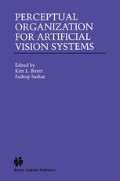Abstract
We have developed a unified computational framework for the inference of multiple salient structures such as junctions, curves, regions, and surfaces from any combinations of points, curve elements, surface elements, in 2-D and 3-D. The methodology is grounded in two elements: tensor calculus for representation, and voting for data communication. The proposed methodology is non-iterative, requires no initial guess or thresholding, and can handle the presence of multiple curves, regions, and surfaces in a large amount of noise while still preserves discontinuities, and the only free parameter is scale. We will demonstrate the approach on a number of examples, both in 2-D and 3-D. Our software is available on the WWW to the community for experimentation and evaluation.
Access this chapter
Tax calculation will be finalised at checkout
Purchases are for personal use only
Preview
Unable to display preview. Download preview PDF.
References
N. Ahuja and M. Tuceryan, “Extraction of early perceptual structure in dot patterns: integrating region, boundary, and component Gestalt,” Computer Vision, Graphics, and Image Processing, vol. 48, pp. 304–356, 1989.
J.D. Boissonnat, “Representation of Objects by Triangulating Points in 3-D space,” Proc. 6th ICPR, pp. 830–832, 1982.
J. Dolan and R. Weiss, “Perceptual Grouping of Curved Lines,” Proc. Image Understanding Workshop, pp. 1135–1145, 1989.
H. Edelsbrunner and E. Mücke, “Three-dimensional alpha shapes,” ACM Transcations on Graphics, pp. 43–72, 13, 1994.
P. Fua and P. Sander, “Segmenting Unstructured 3D Points into surfaces,” ECCV 92, Santa Margherita Ligure, Italy, May 1992, pp. 676–680.
G. Guy, Inference of Multiple Curves and Surfaces from Sparse Data, USC-IRIS Technical Report #96–345, Feb. 96. (Ph.D. thesis).
H. Hoppe, T. DeRose, T. Duchamp, J. McDonald, and W. Stuetzle, “Surface Reconstruction from Unorganized Points,” Computer Graphics, 26, pp. 71–78, 1992.
C. M. Hung and P. G. Buning, “Simulation of Blunt-Fin Induced Shock Wave and Turbulent Boundary Layer Separation”, AIAA Aero. Sci. Conf. (Reno, NV), Jan 1984.
M. Kass, A. Witkin, and D. Terzopoulos, “Snakes: Active Contour Models,” International Journal of Computer Vision, January 1988, pp.321–331.
M.-S. Lee and G. Medioni, “Inferring Segmented Surface Description from Stereo Data”, in Proc. IEEE Computer Vision & Pattern Recognition (Santa Barbara, CA), pp.346–352, 1998.
G. Medioni, M.-S. Lee, and C.-K. Tang, A Computational Framework for Feature Extraction and Segmentation, Elsevier, 1999.
H.-G. Pagendarm and Birgit Walter, “Feature Detection from Vector Quantities in a Numerically Simulated Hypersonic Flow Field in Combination with Experimental Flow Visualization”, in Proc. IEEE Vis’ 94 Confi., pp. 117–123, 1994.
P. Parent and S.W. Zucker, “Trace Inference, Curvature Consistency, and Curve Detection,” IEEE Trans. Pattern Analysis and Machine Intelligence, vol. 11, no.8, 1989, pp. 823–839.
T. Poggio and F. Girosi, A theory of Networks for Learning, Science, 247, pp. 978–982, 1990.
S. Sarkar and K.L. Boyer, “Integration, Inference, and Management of Spatial Information Using Bayesian Networks: Perceptual Organization,” PAMI, vol. 15, no. 3, pp. 256–274, 1993.
A. Sha’ashua and S. Ullman, “Structural Saliency: the Detection of Globally Salient Structures using a Locally Connected Network,” in Proc. Intl Conf. on Computer Vision, 1988, pp.321–327.
J. Shi and J. Malik, “Normalized Cuts and Image Segmentation,” Proc. Computer Vision and Pattern Recognition, Jun. 1997, Puerto Rico, pp. 731–737.
R. Szeliski, D. Tonnesen, and D. Terzopoulos, “Modeling Surfaces of Arbitrary Topology with Dynamic Particles,” Proc. CVPR, New York, NY, pp. 82–85, 1993.
C.-K. Tang and G. Medioni, “Extremal Feature Extraction from Scalar or Vector Fields”, in Proc. IEEE Visualization Conference’ 98, (Research Triangle Park, NC), pp. 95–102, 1998.
K. Thornber and L.R. Williams, “Analytic Solution of Stochastic Completion Fields,” BioCyber, vol 75, 1996, pp. 141–151.
A. Sha’ashua and S. Ullman, “Structural Saliency: the detection of Globally Salient Structures Using a Locally Connected Network”, in Proc. Int’l Conf. Comput. Vision, pp. 321–327, 1988.
H.-K. Zhao, S. Osher, B. Merriman and M. Kang, “Implicit, Nonparametric Shape Reconstruction from Unorganized Points Using A Variational Level Set Method,” uCLA Computational and Applied Mathematics Reports 98–7, February 1998 (revised February 1999)
S.W. Zucker and R.A. Hummel, “Toward a Low-Level Description of Dot Clusters: Labeling Edge, Interior, and Noise Points,” Computer Vision, Graphics, and Image Processing, vol. 9, no.3, pp.213–234, 1979.
Author information
Authors and Affiliations
Editor information
Editors and Affiliations
Rights and permissions
Copyright information
© 2000 Springer Science+Business Media New York
About this chapter
Cite this chapter
Tang, CK., Lee, MS., Medioni, G. (2000). Tensor Voting. In: Boyer, K.L., Sarkar, S. (eds) Perceptual Organization for Artificial Vision Systems. The Kluwer International Series in Engineering and Computer Science, vol 546. Springer, Boston, MA. https://doi.org/10.1007/978-1-4615-4413-5_12
Download citation
DOI: https://doi.org/10.1007/978-1-4615-4413-5_12
Publisher Name: Springer, Boston, MA
Print ISBN: 978-1-4613-6986-8
Online ISBN: 978-1-4615-4413-5
eBook Packages: Springer Book Archive

